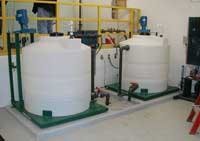Caustic Dilution System Saves Money, Increases Safety
By Mark Nelson
Like buying orange juice and detergents, water treatment chemicals are almost always less expensive to purchase in higher concentrations. Unfortunately, feeding high strength chemicals into process water can create problems for the water treatment operator. These problems may stem from things like extremely low feed rates, chemical off–gassing, hard process water and safety or regulatory concerns in handling high strength chemicals. An innovative engineer and a determined Northwestern city set out to solve these problems with a chemical dilution system that met both their budget and design criteria.
Early in 2001, the City of Enumclaw, WA, hired RH2 Engineers in Bothel, WA, to design a pH control system for their main water treatment plant. Project engineer Dan Mahlum was given the task of creating a safe, reliable and cost effective caustic (sodium hydroxide) feed system for the city.
Having designed caustic feed systems in the past, RH2 knew that chemical suppliers typically deliver caustic in the range of 25–49% strength chemical. Although it is far more cost effective to purchase the chemical in these higher strengths, RH2 and the Enumclaw had some safety concerns about operating and servicing a chemical feed system with high strength caustic. In addition, RH2 felt that high strength caustic could cause feeding problems because it freezes at temperatures below 55 degrees, and scaling could be an issue at the process injection point due to the hardness of the process water. It was therefore decided to feed low strength caustic in the range of 5–10% strength.
Buy chemicals, not water
In order to feed low strength caustic, the city had three choices: purchase low strength caustic which is mostly water; manually dilute high strength caustic when it arrives on site; or devise an automated chemical dilution system to reduce the caustic strength on site. Option 1 was disregarded due to the transportation costs in shipping a product that is mostly water. In addition, many chemical companies are reluctant to dilute raw caustic due to the exothermic reaction that takes place when mixing caustic and water. Option 2 (manual dilution) was disregarded because it was labor intensive, could potentially produce inconsistent results, and would further expose operators to the dangers of high strength caustic. It was therefore decided to go with an automated dilution system.
null
null
Weight–based system
Having used weighing systems to monitor chemical tanks in the past, RH2 Engineers knew that a weight based system can be accurate and reliable. They contacted Force Flow Inc. in Concord, CA, to provide a weighing system and controller that would allow caustic and water to be automatically batched into a dilution tank by weight. Among the most important design criteria were the ability to accommodate different starting and ending solution strengths; system accountability through inventory control and process alarms; accuracy and consistency of the diluted chemical strength; and safety and redundancy in the event that the dilution system should fail.
null
System Design
With prior experience in designing dilution systems, Force Flow was able to accommodate all of the city’s needs through some minor changes to existing hardware and software. The company’s Merlin Dilution Controller automatically calculates the necessary amounts of water and caustic based on the chosen beginning and ending chemical strengths.
The system was designed for the operator to accommodate different “neat” (beginning) caustic strengths at will. If the city changes chemical suppliers or if the current supplier changes the strength delivered, operators can adapt the system with the touch of a button. It is just as easy to change the diluted (ending) strength of the caustic. As an added benefit, the city can keep the metering pumps operating in their optimum range simply by adjusting the chemical strength.
Inventory control
Because the Department of Health requires the city to track their caustic usage and compare it to their water flow, detailed accounting of chemical usage was important. By tracking nine different variables such as chemical usage, feed rates and remaining chemical quantities, the dilution controller is able to give the city a full accounting of the chemical feed and dilution process. In addition, by tracking throughput and using timers to track the dilution process, six different process alarms give operators early warning of potential problems with the caustic feed system. Remote monitoring of chemical feed rates and remaining chemical supplies is accomplished through 4–20 mA signals.
Redundancy
Because this plant is the main source of the city’s water supply, RH2 wanted a fully redundant and fail safe system that would allow continuous operation in the event that a failure occurred. The answer to this was found in using two separate dilution systems, each with separate controllers. An auto switchover valve was used to alternate between each of the two systems. If one bank ever is down for maintenance, control can be diverted to the working system until repairs can be made. This redundancy paid off for the Enumclaw in the first few months while they worked through some programming and hardware bugs.
Conclusion
The City of Enumclaw’s concerns about operator contact with high strength caustic, and potential maintenance problems due to scaling and crystallization were alleviated through feeding a low strength caustic solution. By devising an automated onsite chemical dilution system, the city was able to avoid the cost of purchasing pre–diluted chemical, eliminate the labor and safety concerns that manual dilution would demand, and integrate inventory control and process alarms to make their system safe and reliable for many years to come.
About the Author:
Mark Nelson is a process sales engineer for Force Flow in Concord, CA, and can be contacted at [email protected]. Dan Mahlum, project engineer for RH2 Engineers in Bothel, WA, and can be reached at [email protected]. Scott Woodbury with the City of Enumclaw, WA, can be reached at [email protected]


